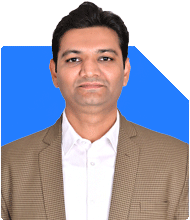Ramalingam Kalirajan |8442 Answers |Ask -Follow
Mutual Funds, Financial Planning Expert - Answered on May 24, 2024
He has an MBA in finance from the University of Madras and is a certified financial planner.
He is the director and chief financial planner at Holistic Investment, a Chennai-based firm that offers financial planning and wealth management advice.... more

SIR, I AM 39 YRS OF AGE WITH MONTHLY SALARY OF 24K, I HAVE INVESTMENT ON SSY-2000/- per month since 2015, LIC - 12000 pm since 2020, Mutual Fund - 1000/- pm since 2021, health insurance flater HDFC Ergo - 2 yrs with Rs. 200000/- sum insured. but I am thinking of cash liquidity of 6 to 10 lakh in next 5 yrs for doing Business what should I do??
Your goal of accumulating Rs. 6 to 10 lakh in the next five years is commendable. Let's explore the best strategies to achieve this.
Current Financial Snapshot
You have made some wise financial choices already.
Your monthly salary is Rs. 24,000.
You invest Rs. 2,000 in SSY since 2015, Rs. 12,000 in LIC since 2020, and Rs. 1,000 in a mutual fund since 2021.
You also have a health insurance plan with Rs. 2,00,000 sum insured.
Your dedication to saving and investing is a strong foundation for your financial goals.
Assessing Your Current Investments
Sukanya Samriddhi Yojana (SSY)
SSY is a long-term investment for your daughter’s future.
It provides good returns and tax benefits.
However, it is not liquid and cannot be used for short-term needs.
Life Insurance Policy (LIC)
Your LIC policy is a significant monthly expense.
While it provides security, it may limit your cash flow.
Review the policy to ensure it aligns with your financial goals.
Mutual Funds
Investing in mutual funds is a good strategy for wealth creation.
Actively managed funds offer professional management and the potential for higher returns.
Ensure you regularly review the performance of your fund.
Evaluating Your Financial Goals
Your primary goal is to accumulate Rs. 6 to 10 lakh in the next five years.
This requires focused saving and smart investing.
Your monthly investments need to be aligned with this goal.
Budget Analysis and Optimization
Creating a Budget
First, create a detailed budget.
Track your income and expenses to understand your cash flow.
Identify areas where you can cut unnecessary expenses.
This will help increase your savings.
Emergency Fund
Maintain an emergency fund of 3 to 6 months’ expenses.
This fund should be easily accessible.
It will provide financial security in case of unexpected events.
Increasing Savings
Automate Your Savings
Set up automatic transfers to your savings account.
This ensures you save before spending on non-essentials.
Reduce Discretionary Spending
Evaluate your discretionary spending.
Cut down on non-essential expenses.
Redirect these savings towards your business fund.
Investment Strategies for Liquidity
Systematic Investment Plan (SIP)
Continue your SIP in mutual funds.
Consider increasing your monthly SIP amount if possible.
Actively managed funds can offer better returns than index funds.
Recurring Deposit (RD)
Open a recurring deposit account.
It is a safe investment with fixed returns.
It also offers liquidity as it can be broken if needed.
Fixed Deposit (FD)
Consider short-term fixed deposits.
They offer higher interest rates compared to savings accounts.
Choose a tenure that aligns with your financial goal.
Debt Funds
Invest in debt mutual funds.
They are less volatile than equity funds and provide better returns than FDs.
They also offer liquidity and are suitable for short-term goals.
Review and Adjust Your Insurance
Health Insurance
Your current health insurance coverage is Rs. 2,00,000.
Review if this is sufficient for your needs.
Consider increasing your coverage to avoid high medical expenses.
Life Insurance
Ensure your LIC policy meets your financial protection needs.
Insurance-cum-investment schemes
Insurance-cum-investment schemes (ULIPs, endowment plans) offer a one-stop solution for insurance and investment needs. However, they might not be the best choice for pure investment due to:
• Lower Potential Returns: Guaranteed returns are usually lower than what MFs can offer through market exposure.
• Higher Costs: Multiple fees in insurance plans (allocation charges, admin fees) can reduce returns compared to the expense ratio of MFs.
• Limited Flexibility: Lock-in periods restrict access to your money, whereas MFs provide more flexibility.
MFs, on the other hand, focus solely on investment and offer:
• Potentially Higher Returns: Investments in stocks and bonds can lead to higher growth compared to guaranteed returns.
• Lower Costs: Expense ratios in MFs are generally lower than the multiple fees in insurance plans.
• Greater Control: You have a wider range of investment options and control over asset allocation to suit your risk appetite.
Consider your goals!
• Need life insurance? Term Insurance plans might be suitable.
• Focus on growing wealth? MFs might be a better option due to their flexibility and return potential.
If the premium is too high, consider adjusting your policy.
This can help free up cash for your business fund.
Planning for Business Capital
Business Plan
Develop a detailed business plan.
This should include your startup costs, operational expenses, and revenue projections.
A well-thought-out plan will guide your financial preparations.
Loan Options
Consider taking a business loan if needed.
Compare different loan options to find the best terms.
Ensure your business plan supports loan repayment.
Government Schemes
Explore government schemes for small businesses.
Some schemes offer subsidies or low-interest loans.
These can provide additional financial support.
Continuous Learning and Improvement
Financial Education
Stay informed about financial management and investment strategies.
Read books, attend webinars, and consult with financial experts.
This will help you make informed decisions.
Regular Financial Review
Review your financial plan regularly.
Adjust your investments and savings based on your progress and market conditions.
A flexible approach will help you stay on track.
Conclusion
Your goal of accumulating Rs. 6 to 10 lakh in five years is achievable.
With disciplined saving, smart investing, and continuous learning, you can reach your financial goals.
Stay focused and make adjustments as needed.
Your dedication and strategic planning will pave the way for your business success.
Best Regards,
K. Ramalingam, MBA, CFP,
Chief Financial Planner,
www.holisticinvestment.in
You may like to see similar questions and answers below
Ramalingam Kalirajan |8442 Answers |Ask -Follow
Mutual Funds, Financial Planning Expert - Answered on Jul 23, 2024
Ramalingam Kalirajan |8442 Answers |Ask -Follow
Mutual Funds, Financial Planning Expert - Answered on Aug 16, 2024
Ramalingam Kalirajan |8442 Answers |Ask -Follow
Mutual Funds, Financial Planning Expert - Answered on Oct 23, 2024
Dr Nagarajan J S K |401 Answers |Ask -Follow
NEET, Medical, Pharmacy Careers - Answered on May 15, 2025
Dr Nagarajan J S K |401 Answers |Ask -Follow
NEET, Medical, Pharmacy Careers - Answered on May 15, 2025
Dr Nagarajan J S K |401 Answers |Ask -Follow
NEET, Medical, Pharmacy Careers - Answered on May 15, 2025
Dr Nagarajan J S K |401 Answers |Ask -Follow
NEET, Medical, Pharmacy Careers - Answered on May 15, 2025
Dr Nagarajan J S K |401 Answers |Ask -Follow
NEET, Medical, Pharmacy Careers - Answered on May 15, 2025
Dr Nagarajan J S K |401 Answers |Ask -Follow
NEET, Medical, Pharmacy Careers - Answered on May 15, 2025
Vipul Bhavsar |83 Answers |Ask -Follow
Tax Expert - Answered on May 15, 2025
Vipul Bhavsar |83 Answers |Ask -Follow
Tax Expert - Answered on May 15, 2025
Vipul Bhavsar |83 Answers |Ask -Follow
Tax Expert - Answered on May 15, 2025
Vipul Bhavsar |83 Answers |Ask -Follow
Tax Expert - Answered on May 15, 2025









.jpg)












